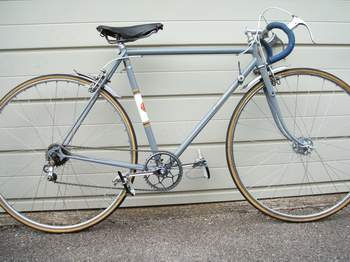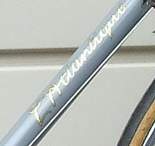Gillott, A S - Lugs and frames
Posted: Monday 08th June 2020
The most famous lug cut is their ‘Fleur de Lys‘, which is a very ancient symbol going back to Biblical times and representing the Virgin Mary, purity and Light. It also became the symbol of the French royal lineage amongst others. So how do you pronounce ‘Gillott’? I say ‘-Gilut-‘ Some Scots say ‘-Ja-lot-‘. John Elder told me had laughed at one chap who pronounced it ‘-Jhee-o-‘. If you consider that Gillott is an Anglicisation of the French name ‘Guillaume’ you will see that the latter is not far from the mark if a little pretentious.
A batch of lugless frames were built for stock in 1949. These differed from the norm in that, on the example I have, the downtube transfer was the A.S.Gillott script instead of L’Atlantique usually used on these frames. The frame number had the year as a suffix instead of the usual prefix.

I have no. 26349, scruffy original finish 24” lugless with brass badge, Simplex boss and braze-ons. It is double-box lined over a metallic indigo blue. This is the only one on the records so far. I believe that the Continental was also offered as a stock design, all other frames being made to order. Continentals had no D/T transfers but A.S.G was wrapped diagonally around the seat tube.
Gillotts men were all racing men so this informed the product. Recommended styles were offered for the different disciplines such as track, grass track, mass start, time trials, touring and general Club work. The variety was subtle, mainly centred on frame angles, wheelbase and bracket height. The essence being on versatility in a time when a cyclist often had but one bike which had to be pressed into service for, perhaps, a time trial on Saturday then a club picnic on Sunday. Harry was also very proud of the bicycles that they built for disabled riders. I have seen a photo in Cycling Plus of a disabled rider at an early 50’s Isle of Wight rally on a Gillott. (If Roger St Pierre reads this I would love a copy for this website, please!) He had probably lost his legs in WW2 and used his left hand to turn the crank, the bracket and chainset being somewhere above the top tube. The frame was totally unconventional but shows the care and patience the company put in to cater for all-comers

Harry also stressed that some of his customers were extremely fastidious and would come in to the shop brandishing angle templates to hold against their new frames. Others came in with totally unbuildable specifications and Harry had gently to persuade them that the thing would be unrideable. He always maintained that comfort was essential for speed so ultra short wheelbases and steep head angles were not recommended but if the customer insisted then that is what he got, within reason. They also specialised in frames for tall riders where taper tubes were recommended (note that ‘taper tube’ is not a model name). They also offered a very neat looking frame for short persons and recommended 26” wheels for it.
NUMBERING
The frame numbering sequence began in May 1945. I understand that the first frames carried the whole year then the number of the frame total from scratch . So the 9th frame built would likely be 19459. as double figures were reached the 1 was dropped so 94510. (I have 94636) and so on until the 1000th frame was sold in 1949 when the 9 was dropped so 491000. This configuration continued, the last known frame in the sequence being 696161 – the 6,161st frame built in 1969. It is in my loft and is a Nervex pro-lugged 21½” track frame fully chromed. Up until circa 1951 the number had been stamped on the steerer tube and BOTH rear dropouts. Sometimes it was stamped where the rear axle nuts graunched it and made unreadable. I have a frame where the number has been restamped. Occasionally they used Stallard rear dropouts and the registration number causes confusion. I also have a frame where the 5 has been filled with braze, this proves that the dropouts were stamped before being brazed in. I have also seen Gillott stems, bolts and expander nuts stamped with the frame number. The stamp size was, until the 1960’s 3/32 of an inch. From circa 1951 the number moved to the bottom bracket and was stamped neatly across the middle. I have seen a track frame from 1952 with frame numbers on the dropouts but I think this is unusual. Sometime in the 1960s the numbers were stamped in a stack reading from top to bottom and were larger, a ¼” stamp set being used.
Posted: Monday 08th June 2020
Contents
This article appears in the following categories.
Upcoming Events
Whether you are looking for a gentle social meet up, or a 100-mile ride browse the community’s upcoming events and plan your next weekend outing.
